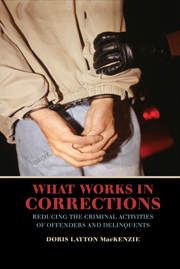Book contents
- Frontmatter
- Contents
- Acknowledgments
- PART ONE STRATEGIES FOR REDUCING CRIME
- PART TWO THE EFFECTIVENESS OF REHABILITATION PROGRAMS
- PART THREE TARGETING SPECIFIC TYPES OF OFFENDERS
- PART FOUR MANAGEMENT AND TREATMENT OF SUBSTANCE ABUSERS
- PART FIVE CONTROL, DISCIPLINE, AND PUNISHMENT
- PART SIX CONCLUSIONS
- References
- Index
- CAMBRIDGE STUDIES IN CRIMINOLOGY
- References
References
Published online by Cambridge University Press: 27 July 2009
- Frontmatter
- Contents
- Acknowledgments
- PART ONE STRATEGIES FOR REDUCING CRIME
- PART TWO THE EFFECTIVENESS OF REHABILITATION PROGRAMS
- PART THREE TARGETING SPECIFIC TYPES OF OFFENDERS
- PART FOUR MANAGEMENT AND TREATMENT OF SUBSTANCE ABUSERS
- PART FIVE CONTROL, DISCIPLINE, AND PUNISHMENT
- PART SIX CONCLUSIONS
- References
- Index
- CAMBRIDGE STUDIES IN CRIMINOLOGY
- References
- Type
- Chapter
- Information
- What Works in CorrectionsReducing the Criminal Activities of Offenders and Deliquents, pp. 347 - 386Publisher: Cambridge University PressPrint publication year: 2006



